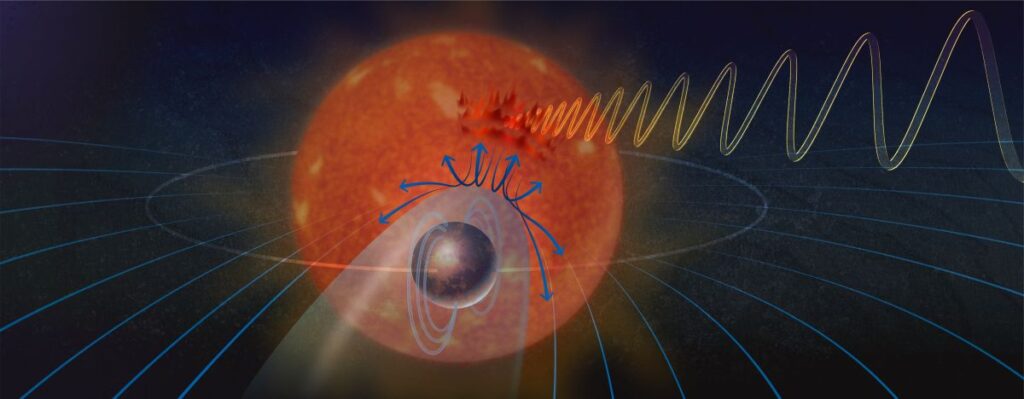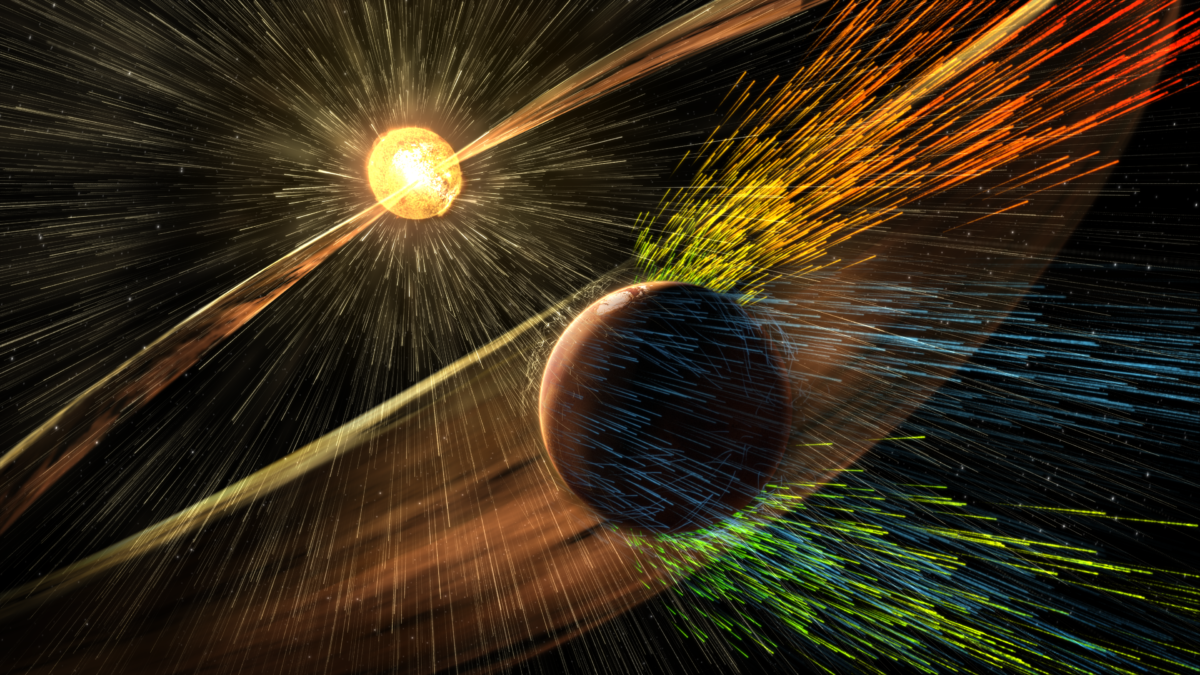Astronomers have detected radio bursts from a small red star that might be caused by magnetic interactions between the star and one of its planets. If future observations reveal more of this activity, the Earth-sized planet would be the first rocky exoplanet discovered to have a magnetic field.
“It’s potentially important for planets to have a magnetic field because it can play a role in whether those planets are habitable,” said J. Sebastian Pineda, an astrophysicist at the University of Colorado Boulder. Pineda is a coauthor of the Nature Astronomy paper that reported the discovery.
So far, astronomers have detected magnetic fields around a few giant-sized gaseous exoplanets. The discovery of a such a field surrounding a rocky exoplanet would offer insight about the interior structure, atmospheric evolution, and potential for life of Earth-sized planets.
Stellar Space Weather
A magnetic field can be both a burden and a boon to a planet, said coauthor Jackie Villadsen, a radio astronomer at Bucknell University in Lewisburg, Pa. It’s like bringing a shield to a water balloon fight: the shield makes you a bigger target, and even though you are protected from a direct hit, you might still get splashed around the edges.
Similarly, a magnetosphere can increase the chance that particles from a stellar flare interact with the planet. But it also fends off some of those particles traveling along a star’s magnetic field lines by bending those lines around the planet.
When the latter happens, the particles release energy that can travel back to the star and cause ripples in the stellar magnetic field lines, like plucking a guitar string, Villadsen explained. Those ripples can create a detectable burst of radio energy.

Using the Very Large Array radio telescope in New Mexico, Pineda and Villadsen searched for radio bursts from the nearby red dwarf star YZ Ceti. The star is just 12 light-years away and has three known exoplanets.
The first several radio bursts they saw were not so strange, the researchers said. Small red stars can be quite active. And though the star is older than the most active stars of similar size, it’s plausible that it still produces strong flares.
But a subsequent burst caught the team’s attention because it occurred just 2 days after a prior one. That interval matches the orbital period of the star’s innermost planet, YZ Ceti b, which is 70% Earth’s mass and probably rocky.
That would be the “absolute smoking gun.”
“The radio waves themselves are coming from near the star’s surface,” like an aurora in the star’s atmosphere, Pineda said. The timing suggests that an interaction between stellar wind and YZ Ceti b’s magnetic field might have caused the bursts. This stellar space weather could be the first evidence of a magnetic field generated by a rocky exoplanet.
The study “is a nice piece of work,” said Philippe Zarka, an astrophysicist at Observatoire de Paris who was not involved with the new research. The two clear bursts are consistent with astronomers’ understanding of how stars and planets interact magnetically, he noted.
But to confirm, the team would need to monitor the star over a long period of time, Villadsen said. If it releases a radio burst every time YZ Ceti b returns to the same spot, the bursts are probably caused by the planet’s magnetic field. That would be the “absolute smoking gun,” Zarka said.
Know the Star, Know the Planet
The researchers could not definitively say that YZ Ceti b has a magnetic field, in part because so little is known about flares produced by older red dwarf stars such as YZ Ceti. Their flares may produce these kinds of radio bursts all on their own.
Past studies have discovered magnetic star-planet interactions for Sun-like stars whose magnetic properties are better understood. “This experiment has yet to be done for small rocky planets around low-mass stars like YZ Ceti,” explained Evgenya Shkolnik, “but this study is an important, early step.” Shkolnik is an astrophysicist at Arizona State University and was not involved with this research.
“The good news is that planetary magnetic fields are ubiquitous in our own solar system,” Shkolnik added, “so they should also be so in exoplanetary systems.”
To understand the planet, you have to first understand the star.
Studying flares and radio bursts from many stars like YZ Ceti will clarify how these kinds of stars typically behave and help researchers home in on planet-generated radio bursts.
“Ultimately, radio telescopes that monitor a wider portion of the sky will be really valuable,” Villadsen said. As would a space-based radio telescope, which could measure the magnetic field–generated radio signal from the planet rather than the star, said Cornell University scientist Jake Turner, who studies exoplanet magnetic fields and atmospheres and was not involved in the new study. (Earth’s atmosphere blocks those lower-energy radio signals from reaching ground-based radio instruments.)
An adage guides exoplanet researchers: To understand the planet, you have to first understand the star.
“‘Know the star, know the planet’ is really, really true here,” Pineda said. “But it’s going to require expanding ‘know the star’ to all sorts of things that so far haven’t been the focus for studying exoplanets.”
—Kimberly M. S. Cartier (@AstroKimCartier), Staff Writer

